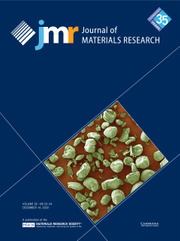Crossref Citations
This article has been cited by the following publications. This list is generated based on data provided by
Crossref.
Szentmiklósi, László
Maróti, Boglárka
Kis, Zoltán
Janik, József
and
Horváth, László Zoltán
2019.
Use of 3D mesh geometries and additive manufacturing in neutron beam experiments.
Journal of Radioanalytical and Nuclear Chemistry,
Vol. 320,
Issue. 2,
p.
451.
Rennie, Adrian R.
Engberg, Adam
Eriksson, Olle
and
Dalgliesh, Robert M.
2020.
Understanding neutron absorption and scattering in a polymer composite material.
Nuclear Instruments and Methods in Physics Research Section A: Accelerators, Spectrometers, Detectors and Associated Equipment,
Vol. 984,
Issue. ,
p.
164613.
Widmann, Tobias
Kreuzer, Lucas P.
Mangiapia, Gaetano
Haese, Martin
Frielinghaus, Henrich
and
Müller-Buschbaum, Peter
2020.
3D printed spherical environmental chamber for neutron reflectometry and grazing-incidence small-angle neutron scattering experiments.
Review of Scientific Instruments,
Vol. 91,
Issue. 11,
T., Sathies
P., Senthil
and
M.S., Anoop
2020.
A review on advancements in applications of fused deposition modelling process.
Rapid Prototyping Journal,
Vol. 26,
Issue. 4,
p.
669.
Zhang, Pengfei
Wang, Zongxing
Li, Junru
Li, Xinlin
and
Cheng, Lianjun
2020.
From materials to devices using fused deposition modeling: A state-of-art review.
Nanotechnology Reviews,
Vol. 9,
Issue. 1,
p.
1594.
Tamayo, P.
Thomas, C.
Rico, J.
Cimentada, A.
Setién, J.
and
Polanco, J.A.
2020.
Micro and Nanostructured Composite Materials for Neutron Shielding Applications.
p.
25.
Brounstein, Zachary
Talley, Samantha
Dumont, Joseph H.
Zhao, Jianchao
Lee, Kwan-Soo
and
Labouriau, Andrea
2020.
Fused filament fabrication of polymer composites for extreme environments.
Journal of Materials Research,
Vol. 35,
Issue. 12,
p.
1493.
Özkalaycı, F.
Kaçal, M.R.
Agar, O.
Polat, H.
Sharma, A.
and
Akman, F.
2020.
Lead(II) chloride effects on nuclear shielding capabilities of polymer composites.
Journal of Physics and Chemistry of Solids,
Vol. 145,
Issue. ,
p.
109543.
GAYLAN, Yasin
BOZKURT, Ahmet
and
AVAR, Barış
2021.
Investigating Thermal and Fast Neutron Shielding Properties of B4C, B2O3, Sm2O3, and Gd2O3 doped Polymer Matrix Composites using Monte Carlo Simulations.
Süleyman Demirel Üniversitesi Fen Edebiyat Fakültesi Fen Dergisi,
Vol. 16,
Issue. 2,
p.
490.
Brounstein, Zachary
Zhao, Jianchao
Wheat, Jeffrey
and
Labouriau, Andrea
2021.
Tuning the 3D Printability and Thermomechanical Properties of Radiation Shields.
Polymers,
Vol. 13,
Issue. 19,
p.
3284.
Bukhvalova, Svetlana Yu
Asmolova, Nina F.
Lopatina, Tatiana I.
and
Bochkarev, Mikhail N.
2021.
Bismuth and thorium fluorides as efficient X-ray radiation shielding materials.
Radiation Physics and Chemistry,
Vol. 182,
Issue. ,
p.
109388.
Brabants, Lowie
Reniers, Brigitte
Cavus, Hasan
Paepen, Jan
Vandoren, Bram
and
Schroeyers, Wouter
2022.
Computed tomography to evaluate the influence of the internal concrete structure on attenuation coefficients.
Radiation Physics and Chemistry,
Vol. 201,
Issue. ,
p.
110433.
Almuqrin, Aljawhara H.
Elsafi, Mohamed
Yasmin, Sabina
and
Sayyed, M. I.
2022.
Morphological and Gamma-Ray Attenuation Properties of High-Density Polyethylene Containing Bismuth Oxide.
Materials,
Vol. 15,
Issue. 18,
p.
6410.
Pazhamannil, Ribin Varghese
V. N., Jishnu Namboodiri
P., Govindan
and
Edacherian, Abhilash
2022.
Property enhancement approaches of fused filament fabrication technology: A review.
Polymer Engineering & Science,
Vol. 62,
Issue. 5,
p.
1356.
Gaihre, Bipin
Potes, Maria Astudillo
Serdiuk, Vitalii
Tilton, Maryam
Liu, Xifeng
and
Lu, Lichun
2022.
Two-dimensional nanomaterials-added dynamism in 3D printing and bioprinting of biomedical platforms: Unique opportunities and challenges.
Biomaterials,
Vol. 284,
Issue. ,
p.
121507.
Ogul, Hasan
2022.
Radiation attenuation properties of polymer composites mixed with tantalum carbide.
Radiation Effects and Defects in Solids,
Vol. 177,
Issue. 5-6,
p.
531.
Baumann, N.
Diaz, K. Marquez
Simmons-Potter, K.
Potter, B.G.
and
Bucay, J.
2022.
Particle loading as a design parameter for composite radiation shielding.
Nuclear Engineering and Technology,
Vol. 54,
Issue. 10,
p.
3855.
Woosley, Smith
and
Aravamudhan, Shyam
2022.
Advanced Additive Manufacturing.
Beck, Devon
Bickus, Jacob
Klein, Ethan
Miller, Paul
Di Cecca, Salvatore
Benz, Ryan
Barney, Andrea
Longton, Robert
Coon, Austin
Smith, Melissa
and
Duncan, Bradley
2023.
Additive Manufacturing of Multimaterial Composites for Radiation Shielding and Thermal Management.
ACS Applied Materials & Interfaces,
Vol. 15,
Issue. 29,
p.
35400.
Kursun, Celal
Gao, Meng
Guclu, Seda
Gaylan, Yasin
Parrey, Khursheed Ahmad
and
Yalcin, Ali Orkun
2023.
Measurement on the neutron and gamma radiation shielding performance of boron-doped titanium alloy Ti50Cu30Zr15B5 via arc melting technique.
Heliyon,
Vol. 9,
Issue. 11,
p.
e21696.


